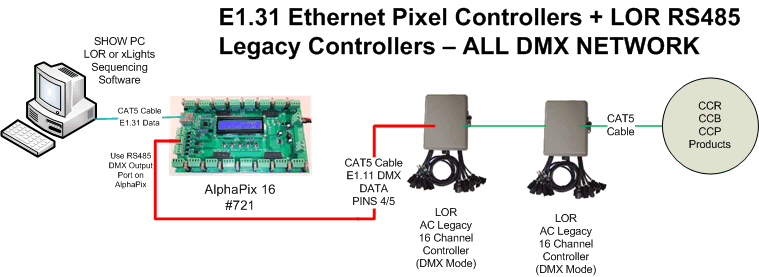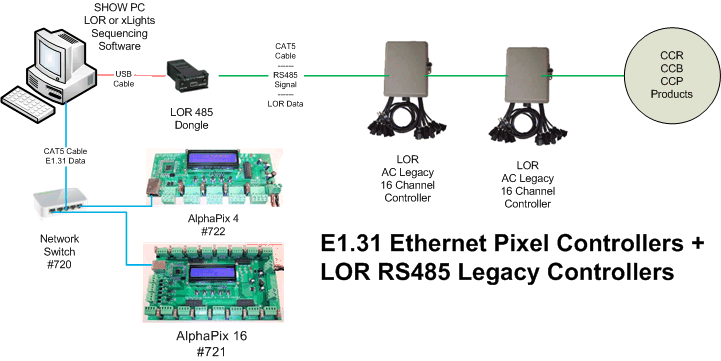Running Legacy RS485 Light-o-Rama Controllers and RS485 Based DMX (E1.11) and Ethernet Based (E1.31) DMX Controllers Together
If you have an existing LOR network or controllers and would like to integrate modern, standards based controllers into that network, this page shows a variety of different options available to you.
NOTE: If you have an LOR "Director", please see this article.

Additional information:
NOTE: If you have an LOR "Director", please see this article.
- LOR Controllers (LOR Protocol over RS485) + E1.31 DMX Pixel Controllers (DMX Protocol over Ethernet) (Preferred / Easiest)
- PROS: Easiest to setup since your existing LOR sequences do not need to be modified - just add the new DMX controllers to your existing sequences. No re-wiring or adaptors required.
- CONS: Requires two separate network cables from your PC (Ethernet port on PC and LOR dongle).
- HOW: You leave your entire LOR setup including your current LOR dongle(s) in place and then just add the E1.31 pixel controllers to your display
- E1.31 Controller(s) - Purchase either a bare controller, a complete kit (MegaTree, Arches, Matrix, etc) or a pre-built Ready2Run pixel controller.
- LOR Controller(s) - Leave all your current LOR controllers exactly where they are with the same wiring and LOR dongle.
- This diagram shows how the above method is commonly used. Your specific network may differ slightly:

- LOR Controllers (LOR Protocol over RS485) + E1.11 DMX Controllers (Complex)
- PROS: Easiest to setup since your existing LOR sequences do not need to be modified - just add the new DMX controllers to your existing sequences. No re-wiring or adapters required.
- CONS: Requires two separate network cables from your PC (DMX dongle and LOR dongle). Requires the purchase of at least two dongles - one for DMX and one for LOR controllers (you may have more depending on the number of LOR and DMX controllers/channels).
- HOW: You leave your entire LOR setup including your current LOR dongle(s) in place and then you add in a DMX output device (dongle):
- ActiDongle - This dongle is used for customers that don't use an existing E1.31 controller that already has a "dongle" built in. It allows you to control up to 512 DMX channels. It plugs into the USB port on the computer and then has a CAT5 cable that goes out to the RS485 based DMX controllers (dumb and pixel based).
- If using a AlphaPix controller as the DMX RS485 source, see this article for specific setup instructions.
- This diagram shows how the above method is commonly used. Your specific network may differ slightly:

Additional information: